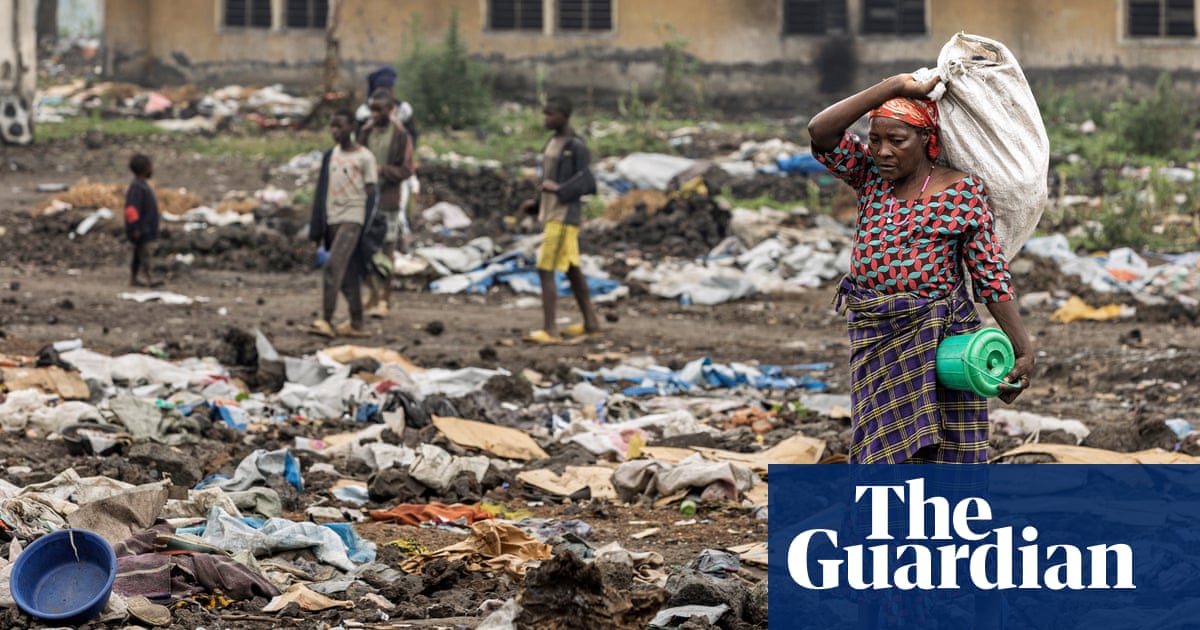
Self-portrait as Cindy, 2022, by Emma Sarpaniemi
Søsterskap highlights Nordic photographers’ strong role over several generations. The exhibition explores the welfare state from a perspective of intersectional feminism. Often referred to as ‘the Nordic model’, this system is characterised by a public sector that provides citizens with social security and welfare services, including daycare and education, and has brought significant improvement to living and working conditions. Les Rencontres d’Arles de la Photographie runs from 3 July to 24 September
Photograph: Emma Sarpaniemi

The American Friend himself, 1976, by Wim Wenders
Wim Wenders on My Polaroid Friends: ‘I shot The American Friend in Hamburg and Paris. It starred Bruno Ganz and Dennis Hopper and was based on the novel Ripley’s Game by Patricia Highsmith. At the time, Polaroid photographs corresponded to what you’d now do on your smartphone. I shot my actors during preparation and between scenes. Even in the story, Polaroids were used, in our case by Dennis Hopper who played Tom Ripley and who became so much our ‘American Friend’ during the film that we changed its title from Framed’
Photograph: Wim Wenders/Wim Wenders Foundation

Ana, circa 1950, by Saul Leiter
Anne Morin on Saul Leiter Assemblages: ‘Photographs are often considered important moments, but they are, according to Saul Leiter, tiny fragments of an unfinished world. Such is his own world, little fragments of images juxtaposed and conjoined, amassing and forming vast, ever-expanding fields. He photographed that which obstructs, hides, encloses, and thus reveals new depths of reality. New York, paradigm of modernity, that city of unceasing rhythm, was for nearly 60 years the locus of his aesthetic finds and optical inventions’
Photograph: Saul Leiter/Saul Leiter Foundation

Spine, 3D, 2023, by Sam Madhu
Habeas Corpus displays a plurality of futuristic visions rooted in reality, and asks how we pose, move, look at ourselves and present ourselves to the world’s gaze. Via previously unseen works, the exhibition questions our systems of values and elucidates the space between desire and rejection of physical, social and political bodies
Photograph: Sam Madhu, courtesy of the artist

Untitled, 2022, by Hannah Darabi
Hannah Darabi: ‘Soleil of Persian Square studies the lifestyle of the Iranian diaspora in LA through its visual identity. I try to put a face on this fictional city, called Tehrangeles, which I discovered in my youth through images related to popular music. The work aims to bring together ordinary scenes of LA and Orange County, which bear signs of this diaspora, portraits of its residents, objects from popular culture (cassette cases, song lyrics, screenshots of music videos from the 1980s and 1990s), and pages from directories related to diasporan activity’
Photograph: Hannah Darabi

Léo, Geneva, 2022, by Yohanne Lamoulère
The starting point for River’s Children was the discovery of an island in the Rhône Delta, in the Camargue. To her roll of film, the photographer brings a gallery of portraits where we meet a host of popular, poetic and wonderful characters, in keeping with the spirit of the utopian watercraft. The Rhône – with a government-recognised level of water pollution – is shown here as docile, fragile, impassive and whimsical
Photograph: Yohanne Lamoulère

Photoshoot with Lili, Wilma and friends, Hunter, New York, 1964-1967, attributed to Andrea Susan
Isabelle Bonnet and Sophie Hackett write about Casa Susanna: ‘In 2004, two antique dealers discovered 340 photographs from the 1950s‒60s at a flea market in New York City. They depicted men dressed as women, whose feminine identity was that of the “respectable” housewife, the girl next door or the kind matron. Behind the photographs lay a vast, hidden network of crossdressers. In spite of the risks, they corresponded with each other, got together and managed to alleviate their isolation’
Photograph: Courtesy Art Gallery of Ontario/Attributed to Andrea Susan

Graçay, Champagne berrichonne, 2023, by Eric Tabuchi and Nelly Monnier
Atlas des Régions Naturelles was begun in 2017. Eric Tabuchi and Nelly Monnier developed this adventure/photographic mission to document every type of construction found in France, without prejudging their qualities. Farms, housing projects, small businesses, agro-industrial complexes, service stations: nearly 20,000 images are accessible online through an interface featuring geographical and typological search criteria. The artists gave this exhibition the oxymoronic title of Soleil Gris (Grey Sun)
Photograph: Atlas des Régions Naturelles/Eric Tabuchi and Nelly Monnier
![Graçay, Champagne berrichonne, 2023 Atlas des Régions Naturelles was begun in 2017. Eric Tabuchi and Nelly Monnier developed this adventure/photographic mission to document every type of construction found in France, without prejudging their qualities. Farms, housing projects, small businesses, agro-industrial complexes, service stations: nearly 20,000 images are accessible online through an interface featuring geographical and typological search criteria. The artists gave this exhibition the oxymoronic title of Grey Sun [Soleil Gris]](https://i.guim.co.uk/img/media/a8b807fa621a74ff2e75bc08d9a5ea4ad3fd3dc9/0_0_7717_5512/master/7717.jpg?width=300&quality=85&auto=format&fit=max&s=6d9af0eb1b1e644945ecafd11188e9fe)
Fragment Amazograms No 5, photogram, 2022, by Roberto Huarcaya
Traces is an extensive body of work by Roberto Huarcaya, a key figure in Peruvian contemporary photography
Photograph: Roberto Huarcaya

Self-portrait as Egyptian Feminist and Activist, Doria Shafik, 2023, by Lina Geoushy
As part of Inheriting and Surrendering the Performance, Geoushy inquires into Egypt’s feminist history. Growing up, she was deeply affected by Egyptian films that were made from the 1940s to the 60s – a period known as the golden age of cinema in Egypt – in which women played powerful characters. These portrayals were in stark contrast to the conservative reality that she witnessed around her. Responding to this dissonance, Geoushy embodies, through performance, different narratives of trailblazing women
Photograph: Lina Geoushy

Figure #77, you can’t recognise what you don’t know, by Ibrahim Ahmed
Also in Inheriting and Surrendering the Performance, Ibrahim Ahmed interrogates his relationship with manhood, and its codification into his body. Reflecting on societal norms – inherited by men across generations – that impose certain performances of masculinity, he enacts gendered stereotypes in his studio. Using collage as rupture, he deconstructs these popular male archetypes, and in turn, disrupts notions of beauty and power
Photograph: Ibrahim Ahmed

Home Series, 2020, by Md Fazla Rabbi Fatiq
Tanvi Mishra writes: ‘Md Fazla Rabbi Fatiq returned from Bangladesh’s capital city, Dhaka, to his hometown, Comilla, at the onset of the Covid lockdown. His work was fuelled by the anxieties that marked this period, when daily objects transformed into sites of possible contamination, and fear hung heavy in the air. Using the language of abstraction, the images play on the uncertainty in the mundane. Flies buzzing on a window surface, veins revealed through transparent skin, feathers strewn across the bottom of a bloody bowl’
Photograph: Md Fazla Rabbi Fatiq

Lucite (They III), 2023, by Eva Nielsen
With Insolare, Nielsen takes on optical and hydrogeological phenomena, combining them with exposure to light (insolation), a technique used in screen printing. Faced with these phenomena and natural forces, drought and rising water, living zones circulate and move in Nielsen’s work, through overlaying silkscreen images and paintings, presenting a fragmented vision of these areas. Matter appears translucent through hybrid printing techniques, or in images deposited one after another in layers during the artist’s various excursions
Photograph: Eva Nielsen

Rhey ran’t ro rhe R, 2018-2019, by Hien Hoang
Tanvi Mishra: ‘“All is well. Across the ocean,” Hien Hoang’s aunt wrote in a letter to her family in 1988, soon after her migration from Vietnam to East Germany. When Hoang visited her aunt in 2014, she was struck by the dichotomy between the tone of her aunt’s letters and the struggle that marked her life. When she moved to Germany herself, confronting the same cliches that her aunt had negotiated, Hoang’s response was not as passive. Across the Ocean is a provocation, and a challenge posed, to the stereotyping of Asian culture by western society’
Photograph: Hien Hoang

Opus 4, 2023, by Daniel Wagener
Danielle Igniti writes: ‘In Opus Incertum – a term borrowed from Roman masonry, which consists of building walls from small blocks, broken tiles and a variety of bricks – the artist questions the memory of time and place, and the social and functional transformations experienced by the Chapelle de la Charité, the religious building and place of worship in which he is exhibiting his work. He seeks to expose the strata that have built up and to connect the site to contemporaneity’
Photograph: Daniel Wagener

A Discreet Exit Through the Darkness series, 2020–ongoing
In 1969, Soumya Sankar Bose’s mother went missing after she went to buy sweets for a religious offering. She was found three years later. In an effort to piece together the incident, Bose examines memory and its shifting nature in A Discreet Exit Through the Darkness. Since his mother’s memory of the time was ‘wiped clean’ due to prosopagnosia – a condition that limits her ability to remember the facial features of the traffickers who kidnapped her – Bose tries to reconstruct the past based on the collective memory of his family members
Photograph: Soumya Sankar Bose











 English (US)
English (US)